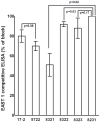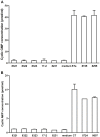Escherichia coli expressing EAST1 toxin did not cause an increase of cAMP or cGMP levels in cells, and no diarrhea in 5-day old gnotobiotic pigs
- PMID: 22905235
- PMCID: PMC3419656
- DOI: 10.1371/journal.pone.0043203
Escherichia coli expressing EAST1 toxin did not cause an increase of cAMP or cGMP levels in cells, and no diarrhea in 5-day old gnotobiotic pigs
Abstract
Background: Enterotoxigenic Escherichia coli (ETEC) strains are the leading bacterial cause of diarrhea to humans and farm animals. These ETEC strains produce heat-labile toxin (LT) and/or heat-stable toxins that include type I (STa), type II (STb), and enteroaggregative heat-stable toxin 1 (EAST1). LT, STa, and STb (in pigs) are proven the virulence determinants in ETEC diarrhea. However, significance of EAST1 in ETEC-associated diarrheal has not been determined, even though EAST1 is highly prevalent among ETEC strains.
Methodology/principal findings: In this study, we constructed E. coli strains to express EAST1 toxin as the only toxin and studied them in cell lines and five-day old gnotobiotic piglets to determine significance of EAST1 toxin. Data from in vitro studies indicated that EAST1 did not stimulate an increase of intracellular cyclic AMP or GMP levels in T-84 cells or porcine cell line IPEC-J2, nor did it enhance LT or STa toxin of ETEC strains in stimulation of cAMP or cGMP in T-84 cells. In addition, 5-day old gnotobiotic pigs challenged with E. coli strains expressing EAST1 as the only toxin did not developed diarrhea or signs of clinical disease during 72 h post-inoculation.
Conclusion/significance: Results from this study indicated that EAST1 alone is not sufficient to cause diarrhea in five-day old gnotobiotic pigs, and suggest that EAST1 likely is not a virulence determinant in ETEC-associated diarrhea.
Conflict of interest statement
Figures




Similar articles
-
Antibodies derived from a toxoid MEFA (multiepitope fusion antigen) show neutralizing activities against heat-labile toxin (LT), heat-stable toxins (STa, STb), and Shiga toxin 2e (Stx2e) of porcine enterotoxigenic Escherichia coli (ETEC).Vet Microbiol. 2017 Apr;202:79-89. doi: 10.1016/j.vetmic.2016.02.002. Epub 2016 Feb 6. Vet Microbiol. 2017. PMID: 26878972 Free PMC article.
-
Detection of virulence factors of Escherichia coli focused on prevalence of EAST1 toxin in stool of diarrheic and non-diarrheic piglets and presence of adhesion involving virulence factors in astA positive strains.Vet Microbiol. 2012 Jan 27;154(3-4):369-75. doi: 10.1016/j.vetmic.2011.07.029. Epub 2011 Aug 4. Vet Microbiol. 2012. PMID: 21864997
-
Genetic fusions of heat-labile (LT) and heat-stable (ST) toxoids of porcine enterotoxigenic Escherichia coli elicit neutralizing anti-LT and anti-STa antibodies.Infect Immun. 2010 Jan;78(1):316-25. doi: 10.1128/IAI.00497-09. Epub 2009 Oct 26. Infect Immun. 2010. PMID: 19858307 Free PMC article.
-
EAST1 toxin: An enigmatic molecule associated with sporadic episodes of diarrhea in humans and animals.J Microbiol. 2019 Jul;57(7):541-549. doi: 10.1007/s12275-019-8651-4. Epub 2019 Jun 27. J Microbiol. 2019. PMID: 31016564 Review.
-
Pig vaccination strategies based on enterotoxigenic Escherichia coli toxins.Braz J Microbiol. 2021 Dec;52(4):2499-2509. doi: 10.1007/s42770-021-00567-3. Epub 2021 Jul 10. Braz J Microbiol. 2021. PMID: 34244980 Free PMC article. Review.
Cited by
-
Antimicrobial Resistance Profiles and Characterization of Escherichia coli Strains from Cases of Neonatal Diarrhea in Spanish Pig Farms.Vet Sci. 2020 Apr 21;7(2):48. doi: 10.3390/vetsci7020048. Vet Sci. 2020. PMID: 32326282 Free PMC article.
-
Antibodies derived from a toxoid MEFA (multiepitope fusion antigen) show neutralizing activities against heat-labile toxin (LT), heat-stable toxins (STa, STb), and Shiga toxin 2e (Stx2e) of porcine enterotoxigenic Escherichia coli (ETEC).Vet Microbiol. 2017 Apr;202:79-89. doi: 10.1016/j.vetmic.2016.02.002. Epub 2016 Feb 6. Vet Microbiol. 2017. PMID: 26878972 Free PMC article.
-
Recent advances in understanding enteric pathogenic Escherichia coli.Clin Microbiol Rev. 2013 Oct;26(4):822-80. doi: 10.1128/CMR.00022-13. Clin Microbiol Rev. 2013. PMID: 24092857 Free PMC article. Review.
-
Evolution of diarrheagenic Escherichia coli pathotypes in India.J Lab Physicians. 2019 Oct-Dec;11(4):346-351. doi: 10.4103/JLP.JLP_58_19. J Lab Physicians. 2019. PMID: 31929702 Free PMC article.
-
A systematic review and meta-analysis of the epidemiology of pathogenic Escherichia coli of calves and the role of calves as reservoirs for human pathogenic E. coli.Front Cell Infect Microbiol. 2015 Mar 12;5:23. doi: 10.3389/fcimb.2015.00023. eCollection 2015. Front Cell Infect Microbiol. 2015. PMID: 25815276 Free PMC article.
References
-
- Black RE, Cousens S, Johnson HL, Lawn JE, Rudan I, et al. (2010) Global, regional, and national causes of child mortality in 2008: a systematic analysis. Lancet 375: 1969–1987. - PubMed
-
- WHO (2006) Future directions for research on enterotoxigenic Escherichia coli vaccines for developing countries. Wkly Epidemiol Rec 81: 97–107. - PubMed
-
- USDA (2002) USDA:APHIS:VS, CEAH, Nat. Anim. Health Monitoring Syst. Part II: Reference for swine health and health management in the United States, 2000, Ft. Collins, CO.
-
- Frydendahl K (2002) Prevalence of serogroups and virulence genes in Escherichia coli associated with postweaning diarrhoea and edema disease in pigs and a comparison of diagnostic approaches. Veterinary microbiology 85: 169–182. - PubMed
Publication types
MeSH terms
Substances
Grants and funding
LinkOut - more resources
Full Text Sources
Medical

